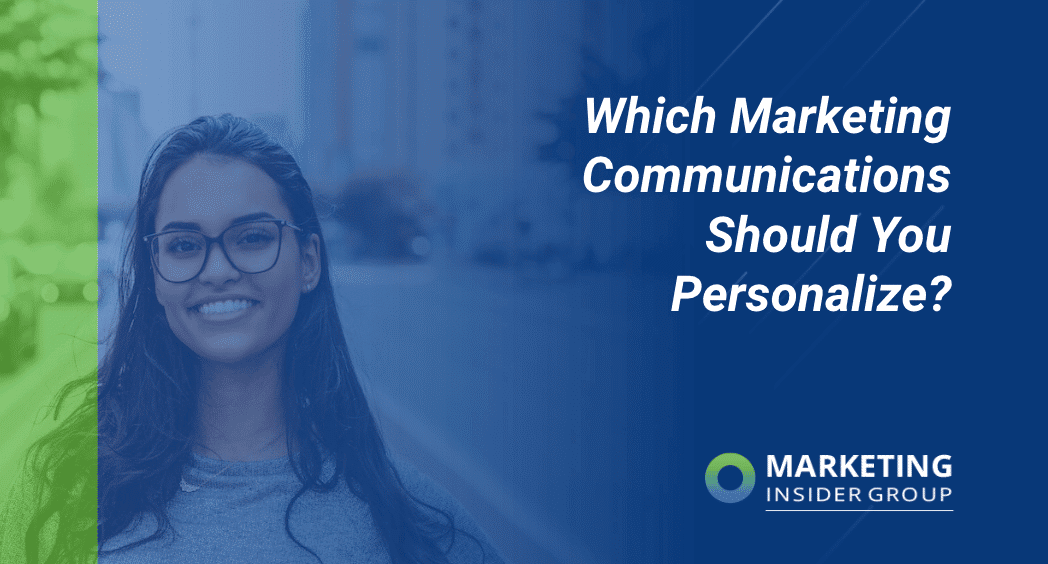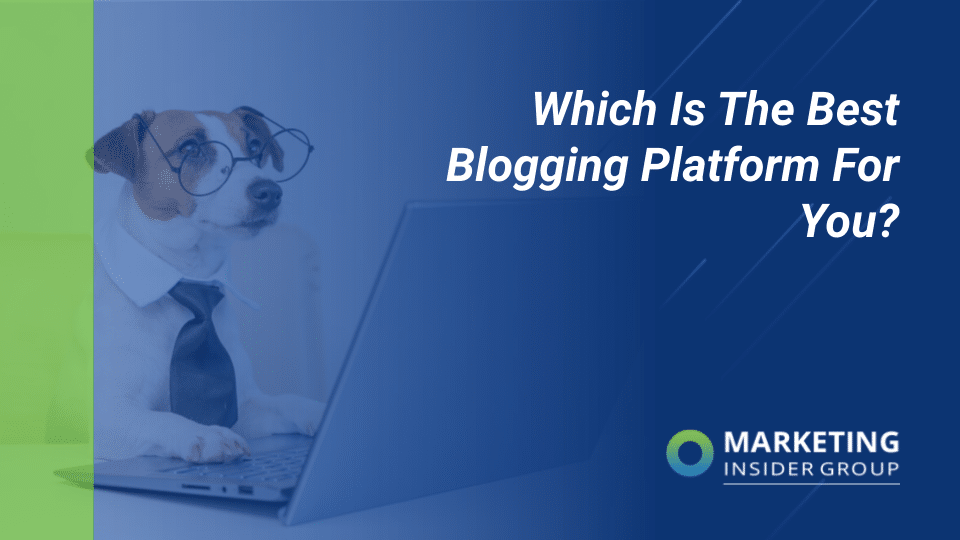
Which Marketing Communications Should You Personalize?
With the emergence of content “spam” generated by AI tools like ChatGPT and others, personalizing your marketing communications has become more important than ever.
Why? Google has updated their algorithms to look for more helpful content. Readers as also looking for more human-generated content that is more, well, human.
Instead of “E-A-T” content that shows expertise, authority and trustworthiness, we are also looking for writing that conveys “experience” that no AI-generated piece of content can ever authentically replicate.
So no, AI is not about to replace human writers. Because only human writers have the expertise, authority, trustworthiness and experience that we’re all looking for. But there is one additional way we need to think about when creating our content: personalizing our marketing communications.
Every customer is different. They have different needs, interests, and motivations. So doesn’t it make sense to treat them accordingly? We’ve entered a new era of marketing where customers expect a relevant experience that’s matched to their specific needs. People don’t want to feel like just another number on a list, they want to feel like human beings, and it’s up to us to treat them that way.
Personalization has proven to be a highly effective marketing strategy. And we have covered how AI can be used in conjunction with personalization to improve the quality of leads. Want some proof:
- Infosys reported 59% of consumers say that personalization influences their shopping decision.
- McKinsey has reported found that 79% of customers will only engage with new offers if these are personalized.
- MarketingProfs discovered businesses that personalize web experiences see, on average, a 19% increase in sales.
If you’re trying to speak to everyone, you’ll end up speaking to no one. So it’s time to clearly define your target audiences and personalize their experiences.
What is Personalized Marketing Communications?
Personalized marketing communications are those that use data to customize the messages each person receives based on patterns of their behavior.
For example, readers of an early-stage article like “what is content marketing” might receive a notification to check out the next article in the series, “why content marketing is important.”
This requires extensive use of data and content predictions that are dependent upon mapping content to the buyer journey. Using the examples above, we might also suggest content for the next stage of the buyer journey from what and why to how to develop a content marketing strategy, how long does it take to work, how much does it cost, etc.
I could go on and on!
Some other marketing communication personalization strategies include approaches based on various data points such as:
- Persona: who you are. For example, you could send one type of message to VPs and another to users of your product.
- Reader behavior: what you do while surfing the web such as dynamic links and offers based on what you read, where you click, etc.
- Geography-based: where you are from. Some websites tell you what the weather is based on your IP address. (Creepy?)
- Channel-based: where you are consuming content. Let’s explore some of these in some more details…
How To Apply Channel-Based Marketing Personalization
Website
Your website is a great starting point for personalizing marketing communications. IBM reported that one of their clients saw a 400% increase in response rates from personalized website offers. There are a number of ways to personalize the content on your website.
If you run an e-commerce and online shopping websites, you can personalize offers according to the customer’s account details and shopping history. Here are two great examples from Amazon:
- When logged in, they have links on the menu/navigation area with the user’s first name such as “Emma’s Amazon.com” (instead of just Amazon.com) and “Hello, Dan” (which links to the account menu options).
- Using information from a user’s browsing history, Amazon.com provides recommendations on products that a person might buy or might find of interest in the future by showing these on the homepage on their next visit.
These examples and many other personalized elements on websites occur through the use of dynamic content, which in simple terms is “HTML content on your website, forms, landing pages, or emails that change based on the viewer.”
PS – We actually use a form of this on our website to display different offers using a wordpress plug-in called AdRotate.
You can personalize almost any kind of messaging on your website to the current viewer, as long as you have the right information about them. For example, instead of saying “free international shipping,” use the visitor’s public IP address to detect their location and say “free shipping to [your state]” instead.
Emails
We’re well past the days of marketing personalization by using “hey [FIRST NAME] emails.”
Emails remain the most common means by which businesses communicate directly with their customers. Almost 9 out of 10 marketers say that email is their primary means of lead generation, but it’s marketers who use personalization in their subject lines that see 26% more opens. However, email personalization goes beyond including the customer’s first name in the subject line.
An important email personalization strategy is segmentation. The first step is to make sure you have the right data. For example, if you’re looking to send industry-specific campaigns via email, aside from asking for the usual ‘name and ‘email’ fields from subscribers, include a dropdown for industries like retail, real estate, food, manufacturing, marketing, and others.
Then, segment your email lists by industry so that you can send emails that are more relevant. If you have transactional data such as past product purchases or current subscription plans, then offer related products or discounted subscription upgrades in your emails.
Another great personalized email tactic is the use of automated behavior-triggered emails. Take language teaching app, Duolingo, as an example. They send out an email to users who haven’t taken lessons after a specific period with the subject line “We miss you!”
Social Media
Social media is now a standard tool for any successful marketing strategy. New Media Marketing reported that about 76% of businesses use social media to achieve marketing objectives, and retailers have experienced 133% in increase in revenues after promoting via social media. Because social media is all about connecting with your audience, personalization is a key tactic to consider.
Custom Audiences is a great way to personalize. Available to any business that advertises on Facebook, the feature allows you to create a ‘Custom Audience’ by uploading a customer list with information like purchaser email addresses (which Facebook will encrypt upon upload). Then, you can target your Facebook ad to your desired audience.
A great application of this is if you have a list of people who did a free 30-day product trial, you can send them specific ads that remind them to upgrade their accounts. If you’re running a Facebook campaign to get more email newsletter subscriptions, you can also use a custom audience list to exclude your existing subscribers from seeing the ad.
Twitter also offers a similar feature called Tailored Audiences.
Needless to say, the most basic way to personalize communications on social media is to engage with individual accounts. Responding personally to their direct messages and mentioning them in posts shows them that you care about them as individuals.
Online Advertising
Advertising on places like the Google Network (including Google Search, YouTube, Gmail, etc.) can be rewarding, especially if you know how to personalize your ads using available features.
One way is to take advantage of Google’s Customer Match. Very similar to Facebook Custom Audiences, Customer Match lets you use an uploaded list of email addresses which can then be matched to a list of users on Google so you can target them.
For example, if you have a list of emails who signed up for a webinar on social media marketing trends. You can choose to retarget these individuals by showing ads that link back to your website when they use keywords like “social media.” Of course, these ads will only be shown to those specified emails.
Re-marketing and re-targeting are personalization tactics that takes advantage of a user’s browsing history (via browser cookies). You’ve probably experienced it first-hand: if, for examples, you googled Adidas Stan Smith shoes and started seeing banner ads on random websites that link you to an Amazon landing page with those same shoes.
Afterwards, you closed the window and started browsing Facebook, then voila, the exact same Amazon.com page for Adidas Stan Smith is now on your Facebook sidebar ads. Re-marketing is available on Google and can also be applied to Facebook using Custom Audiences.
Personalizing Your Marketing Communications Is The Key To Success
Personalizing your marketing strategy is a key tactic to succeed in communicating with your customers in today’s AI-freaked-out age.
As you make the most of dynamic content on your website user experience, segment subscribers in your email marketing campaigns, target custom audiences on Facebook, and use personalized PPC strategies, remember to use personal information such as names and email addresses with care and in a way that does not violate customer privacy.
It’s one thing to offer personalized communications to improve the customer experience. It’s another thing entirely if your brand comes off as creepy.
Ready to get more traffic to your site with quality content published consistently? Check out our Content Builder Service today!







Excellent post Johanna! What data sources are you seeing successful marketers use to personalize their client experiences?